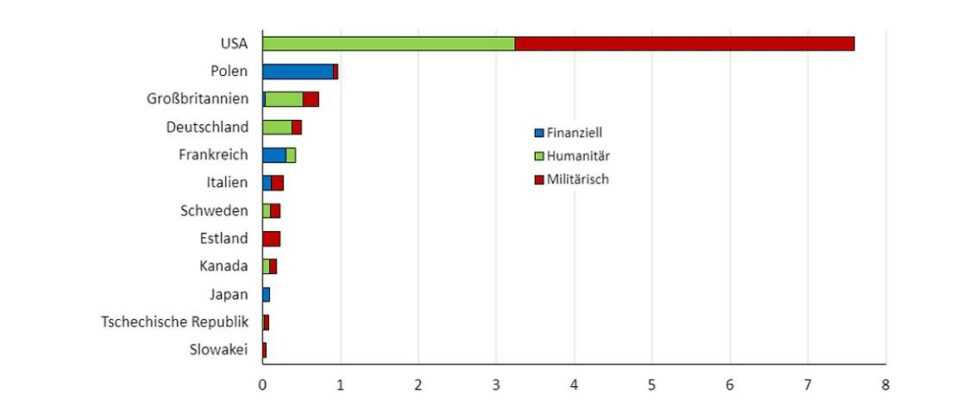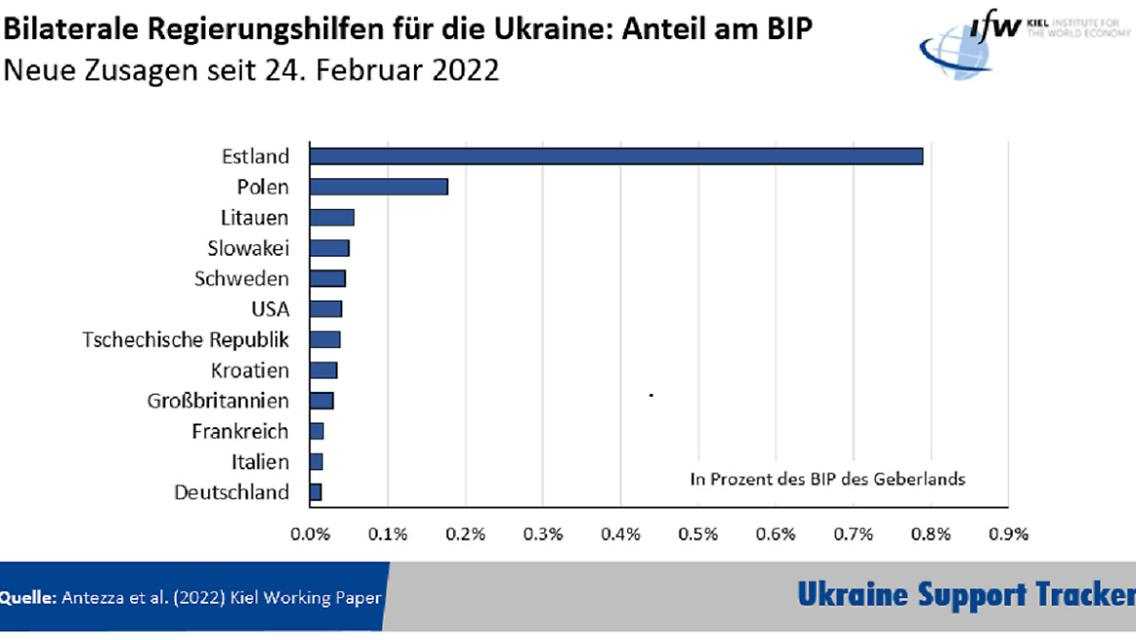Institute creates database
Where does most of the aid to Ukraine come from?
By Maximilian Beer
4/20/2022, 4:44 p.m
In the war with Russia, Ukraine needs support – it needs weapons, money and humanitarian aid. The Institute for the World Economy uses a database to calculate which countries are giving how much to Kyiv. In terms of GDP, one EU country comes out on top – Germany is not.
Those who had expected the federal government to change course were disappointed by Olaf Scholz: On Tuesday, the chancellor promised that Germany would support Ukraine indirectly through its armaments industry, and further arms deliveries were also planned. However, the Social Democrat once again rejected the idea of passing on heavy military equipment for the fight against the Russian armed forces. “Look around at what others who are closely allied with us are doing, what they are delivering,” said Scholz. “Those who are in a situation comparable to Germany act like us.”
Now the question is whether this statement is true at all. After all, according to reports, the Czech Republic has already delivered tanks, and the USA and the Netherlands have also announced that they will hand over heavy equipment to Ukraine. Against this background, Scholz’ creed that “German solo efforts would be wrong” is dubious, and the Union even calls it “cynical.” Another question is whether the federal government has so far acted in step with its partners when it comes to the scope of the aid.
The Kiel Institute for the World Economy (IfW) wants to “support the discussion about support for Ukraine with facts”. The IfW has one for that Database created, in which promised “military, financial and humanitarian aid” are recorded. This resulted in a ranking showing which countries gave how much. For their evaluation, the researchers used public sources, i.e. government information and media reports. However, the current status of the “Ukraine Support Tracker” only refers to the period between the Russian invasion on February 24th and March 27th. The project is to be continued in the coming weeks.
The US gives more than the entire EU
If you look at the absolute numbers, Germany ranks fourth among the 31 countries. The amount of around half a billion euros is made up of 0.37 billion for humanitarian aid and 0.12 billion for military support. For comparison: According to the IfW, private donors in Germany provided 631 million euros for humanitarian aid in Ukraine by March 25. The list of nation states is headed by the USA (almost 7.6 billion euros), well ahead of Poland and Great Britain.
For the first month of the war, the IfW comes to a total of around 13 billion euros in aid for Ukraine. To evaluate individual deliveries, such as armaments or medicines, the researchers used official sources, new prices, information from previous aid campaigns or prices on online marketplaces.
“It is remarkable that the USA alone gives significantly more than the entire EU, in the immediate vicinity of which the war is raging,” says Christoph Trebesch, who, as research director at the IfW, is responsible for the “Ukraine Support Tracker”. According to the database, the EU countries together come to around 2.9 billion euros, plus 1.4 billion from EU institutions and 2 billion from the European Investment Bank.
The picture is very different if you put the figures in relation to the economic performance of the national economies. If the gross domestic product (GDP) is taken into account, according to calculations by the IfW, Germany is only in twelfth place in the ranking. The USA is also passed down and ends up in sixth place.
First place: Estonia, whose military, financial and humanitarian aid in the first weeks of the war corresponded to 0.79 percent of its own GDP. Tallinn supported Kyiv – partly after legally required approval from Berlin – with extensive arms deliveries. Poland, Lithuania and Slovakia follow. The Baltic and Eastern European states in particular have felt increasingly threatened by Moscow in recent years. The relatively large support of some countries can probably also be explained against this background.
However, the ranking cannot be transferred to the current status because interim commitments have to be added later. “The almost 2 billion euros in military aid announced by Chancellor Olaf Scholz have given Germany a clear boost in the ranking,” Trebesch, research director, told ntv.de. “Should the aid flow, Germany would probably be in second or third place. In terms of gross domestic product, it would be fifth or sixth.” According to preliminary figures, German commitments up to April 17 amounted to 4 billion euros. This includes military aid, new KfW loans and several hundred million euros for the EU support package “European Peace Facility” and EU aid.
In addition, there is sometimes insufficient data, for example in relation to arms deliveries. These are not always communicated in times of war, for security reasons, as the federal government emphasizes. The French have also been extremely reluctant to make public announcements in recent weeks. Only once did the government provide information about the delivery of defensive weapons, it says report to the IfW evaluation. In the case of France, the IfW researchers therefore completely refrained from accepting military aid.
“In response to media reports on German arms deliveries, the federal government gradually released information,” Trebesch said when asked by ntv.de about possible gaps in the database. “Of course there is a risk of underestimating the amount of aid because not everything is made public.” However, when in doubt, the researchers would have set ever higher values, which is why the aid could also be systematically overestimated. “We measure the commitments made by the governments, that is, the promises made, but it is often unclear when and if the full amount of aid will arrive in Ukraine.”

